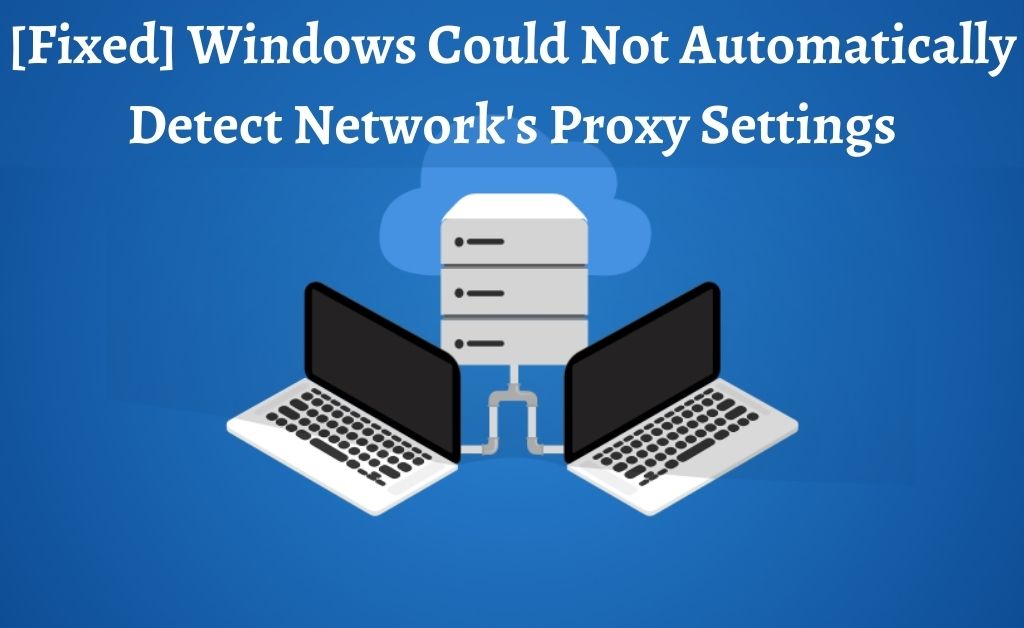
Windows could not automatically detect this network’s proxy settings due to certain crucial reasons. And, they are like corrupted system files, blockades of anti-virus firewall, data packet loss, network cache files and others. When the network settings are accurate, then the proxy settings will also work without any glitch. A critical situation only takes place when you receive such error messages regarding the proxy settings.
Before moving on to the fixing methods, you must know the types of proxy errors that can take place. The messages that are related to the error appear like this: “Windows cannot detect proxy settings”, “Windows could not automatically detect proxy server”, “Windows won’t save proxy settings”, “Windows proxy settings keep changing”.
What is the meaning of all the messages? Let’s check them one by one. The first message is the most common one and you can resolve it with the help of any one of the fixing methods mentioned here. The second message occurs due to some malfunctions in the configuration. The third one appears when the system is unable to save the proxy settings. And the last one indicates any unexpected changes in the proxy settings. Now, let’s fix the error.
-
Examine the Settings of the Proxy Server
To gain access to the Proxy server, you need to go to the Internet Properties with the help of the Control Panel. As there are several tabs, you need to click on the Connections tab and then on to the LAN settings. Now, study all the options very carefully. Make the desired changes and click on OK to save the settings. This might resolve the Windows could not automatically detect this network’s proxy settings error.
-
Format the TCP/IP Protocol
Run the Command Prompt, grant administrator rights to reset the TCP/IP settings.
“Netsh int IP reset
Resetlog.txt”
These commands will help you to revert back the TCP/IP protocol to its system default settings. The next step will be rebooting your system and checking whether the issue is resolved or not.
-
Create a Restore Point
If you have recently updated the OS, then Windows could not automatically detect this network’s proxy settings. It’s not that easy to uninstall the recently downloaded updates. So, you need to choose the system restore process. The very first step is to establish a system restore point in your computer.
After the System Properties window opens, select the default system drive and click on the System Restore button. Now, follow all the instructions on the screen and proceed step by step. When the system is rolled back to the previous version, the issue will be resolved.
-
Check the Security Application
There are some security features in your antivirus software that might lead to Windows could not automatically detect this network’s proxy settings. The application actually blocks the proxy addresses so that no unauthorized intruders can gain access to your network. When you are confident about the proxy address that it cannot be breached, it’s better to uninstall the security software for some time.
From the list of installed applications, search and find out the security software. When the removal process is done, reboot your system and check the proxy settings.
-
The SFC Scan
Perform the SFC scan for the entire system with the help of the “sfc/scannow” in the Command Prompt. The operation might take 8 to 15 minutes. The elapsed time duration basically depends on the system configuration. After the successful scan, your computer will definitely be able to detect the proxy settings correctly.
-
Switch to Default Internet Settings
Switching on to the default internet settings will require the formatting process. Type Internet Options in the Cortana bar. Navigating through the Advanced tab in the Internet Properties, you will easily locate the Reset button at the end.
Click on it to get the confirmation window. Once again, click on Reset. Now, finish the process with the help of the OK button. Your system will be free from getting the Windows could not automatically detect this network’s proxy settings error.
-
Put off the Network Adapter
The credentials of the network adapter will get deleted if you reset or format the network adapter. Proceed to the Network Settings by right-clicking on the WiFi icon present on the Taskbar. Select the Ethernet adapter and disable it. After some time, follow the same steps to enable it.
-
Let the System detect IP Address Automatically
There are two main ways to configure the internet — The first one is putting all the correct internet credentials and the other is letting the system do it automatically. Performing these two procedures will solely depend on the type of network connection you use. Your computer will only detect the network connection automatically if and only if you are using a static IP.
In the case of dynamic IP, you have to manually input the proxy address. In the network Ethernet adapter lies the properties and the TCP/IP version 4. Select the radio button of the automatic option to detect the proxy, automatically.
Lastly….
Sometimes when your broadband connection doesn’t work, you take the help of the mobile internet service. This service does not need any type of proxy address or settings. If needed, contact your mobile operator helpline to get more valuable information. As the involvement of the security application is already there, look for your desired choices.
Make sure you choose such a security application that will not interfere with the network configuration or settings. On the other hand, this will also help to eliminate many technical glitches. Further, before connecting to the internet, make sure you delete all the cache files from your system. These files can create a barrier in the network settings.
